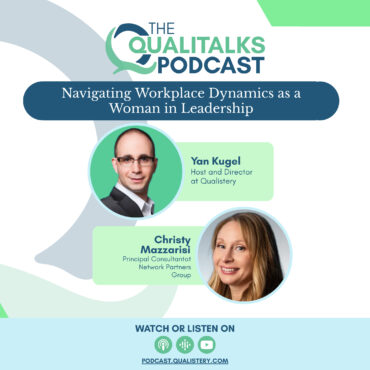
How to Choose and Qualify Autoclaves and What Pitfalls to Avoid
In this podcast episode, our guest is Chris Maughan, a Sterilisation and Validation Consultant.
 play_arrow
play_arrow
Agility in Pharma: Transforming Challenges into Opportunities [Elizabeth Hickman] Elizabeth Hickman
 play_arrow
play_arrow
Navigating Workplace Dynamics as a Woman in Leadership [Christy Mazzarisi] Christy Mazzarisi
Nathan Roman March 9, 2023 666

Table of Contents
One of the most common concerns in GxP quality is maintaining the temperature of laboratory and manufacturing storage environments. Temperature Mapping, also known as thermal mapping, is an activity performed on temperature-controlled chambers often used to track temperature changes within the storage space over a long period.
This podcast episode focuses on the importance of temperature mapping studies and why they are so critical for pharmaceutical compliance. Our guest speaker is Nathan Roman, one of the top experts in Temperature control mapping who help people in the Health & Life Science industry learn how to implement and carry out temperature mapping studies and equipment qualifications (IQ, OQ, PQ).
Yan Kugel interviewed Nathan Roman about the purpose of thermal mapping and why it is required in the bio industry. Nathan also lays out the process for a temperature mapping study, including protocol generation, approval signatures, and execution.
So tune in to learn all there is to know about thermal mapping and its impact on pharmaceutical compliance!
This episode is sponsored by Eupry, a leading provider of comprehensive environmental monitoring and validation solutions for regulated industries. With a focus on temperature, CO2, humidity, and differential pressure, Eupry helps companies ensure compliance with industry standards and regulations. All that while providing reliable and accurate data to support informed decision-making.
Thermal Mapping is a process for validating the temperature uniformity and stability of pharmaceutical storage and distribution systems. It ensures that pharmaceutical products are produced in line with the relevant Good Manufacturing Practice (GMP) standards. This article will explore the key elements of Thermal Mapping and explain why it is so important for pharmaceutical manufacturers. We will also look at the process of Thermal Mapping and the major difficulties associated with it.
Thermal Mapping is an essential tool for any pharmaceutical facility, as it provides data on temperature consistency in critical areas and equipment. In addition, it plays a crucial role in ensuring compliance with Good Manufacturing Practices (GMP). Providing reliable temperature data helps identify and rectify problems before they lead to costly recalls or product loss. In 2019, the IQVIA Institute for Human Data Science declared that the biopharma sector alone loses about USD35 billion annually because of the failure to control temperature.
Thermal Mapping is the process of recording the temperature at different points in a warehouse, cold room, refrigerator, freezer, ultra-freezer, or transportation vehicle over a period of time. It helps to identify temperature variances and establish if these variations are between acceptable temperature limits.
Nowadays, regulatory agencies demand the Thermal Mapping of temperature-controlled areas to assure the quality of the drug product. The EU-GDP (Good Distribution Practice) Guidelines Chapter 9.4 specifies that Temperature Mapping should be performed under representative conditions.
Monitoring temperature levels helps to ensure that raw materials, finished products, and their containers are stored at optimal temperatures. The main objective of performing a Thermal Mapping is to ensure that a temperature-controlled space is suitable for its intended purpose. It is an essential tool for ensuring the quality and integrity of medicinal products through the entire supply chain to the patient.
Thermal Mapping involves a detailed survey designed to accurately assess and document the environmental conditions. The documented temperatures must not exceed the limits set out in the GMP for the safety and efficacy of products. When a temperature-sensitive Pharmaceutical Product is exposed to temperatures outside the product specification range, it is called temperature excursion. The targeted thermal Mapping should include, but not be limited to, freezers, refrigerators, incubators, and cold rooms.
Accurate Thermal Mapping requires the use of temperature data loggers. A data logger is a device that records and stores temperature readings at set intervals over a period of time. The team must decide the location of each temperature sensor. To perform a comprehensive thermal mapping, the team should be able to identify and document potential hot and cold spots in temperature-controlled areas. In addition, they must document any cooling systems, air-conditioning, and/or air-flow systems.
The team in charge of performing the Thermal Mapping must be properly instructed on the techniques, process steps, and the necessary equipment.
Attention all pharma professionals!
Stay ahead of the game and be fully compliant with regulations.
Join Qualistery’s expert-led educational webinars and stay up-to-date with the latest trends and regulations.
With top industry providers as our partners, we bring you the best speakers and informative sessions.
Visit our website to browse our upcoming webinars and take the first step toward furthering your knowledge and success in the industry.
Don’t miss out on this opportunity to invest in your professional growth.

Temperature mapping is a critical part in the qualification of areas and equipment. This process is used to test and monitor the quality of the end product and consists of 4 steps: Planning and Preparation, execution, data analysis, and report writing.
Proper planning and preparation are vital for successful thermal Mapping. This includes setting up a temperature test plan. The temperature test plan should include the type of tests that will be performed, the specific conditions for the testing, and any associated documentation.
Additionally, it is important to ensure that all necessary equipment and personnel have been identified in advance. It is also important to have the proper calibration and maintenance records for the equipment used in the testing.
Once the plan has been established, the next step is to develop the protocol. This document describes a specific procedure to perform Temperature Mapping. It contains several sections: scope, objective, responsibilities, equipment description, and process. At this step, deciding and documenting the positions where the data loggers will be placed in the equipment or room to monitor is essential.
The protocol should also include various conditions that typically involve:
All normal operations like loading and unloading should happen as usual, and those actions should be recorded and analyzed to find any abnormal variations. The acceptance and rejection criteria are also defined here.
After the protocol is reviewed and approved by all the involved personnel, the execution takes place. The designated person programs and places the data loggers at predetermined positions. During the test, the temperature of the product is monitored and logged at specific intervals. Once the testing is complete, the person collects the devices and downloads the data to a computer.
The data gathered during the thermal mapping process is used to generate a thermal map of the product or process. This map provides a visual representation of the temperatures experienced in each area. This information can then be used to identify potential issues and make necessary adjustments to the process or product.
Analyzing the test results involves looking at the temperature data collected during testing and comparing it to the defined parameters set by the GMP guidelines. This helps to identify any variations or anomalies that may have occurred during testing. The analysis of the results should also include an evaluation of the accuracy of the test and an assessment of any corrective action that may be necessary.
The results should be comprehensively documented in a report. It should include a conclusion that clearly describes if the equipment/room is appropriate for the intended use and an assessment of any corrective action that may be necessary (such as making adjustments to the process or changing the setpoint of the equipment).
The importance of thermal Mapping and validation in the pharmaceutical industry cannot be overstated. From ensuring the safety and efficacy of a drug to meeting Good Manufacturing Practice (GMP) standards, thermal Mapping plays a massive role in the success of a product. It is a detailed process requiring expertise and understanding of the processes and equipment.
Thermal Mapping allows the evaluation of temperature profiles of a particular area or equipment during manufacturing, storage, and transportation. It helps to ensure that any changes in temperature during these processes are in line with the product’s specification and cannot harm the product or the patient.
In addition to ensuring the quality of the product, the thermal mapping process also helps companies save time, resources, and money by improving their process efficiency. For example, it helps to identify areas of heat or cold air leakage and determine how they can be better controlled, reducing the energy costs associated with the process. It also enables manufacturers to improve the monitoring of their equipment and better understand when small changes in temperature or other environmental parameters affect the process.
In conclusion, Thermal Mapping is critical for any pharmaceutical company dealing with temperature-sensitive pharmaceuticals. Even though it is a complex process requiring expertise in processes and equipment, the benefits far outweigh the effort.
[simple-author-box]
[mailerlite_form form_id=1]
Tagged as: Temperature Mapping, Temperature Validation.
Over the last 22 years I’ve placed thousands of temperature sensors in hundreds of control temperature chambers. Building on that experience, I’m continuously improving my efficient processes for faster delivery of fully qualified chambers for use. My name is Nathan Roman, and I have a passion to help others. I help people in the Health & Life Science industry learn how to implement and carry out temperature mapping studies and equipment qualifications (IQ, OQ, PQ).

In this podcast episode, our guest is Chris Maughan, a Sterilisation and Validation Consultant.


Copyright © 2023 Qualistery